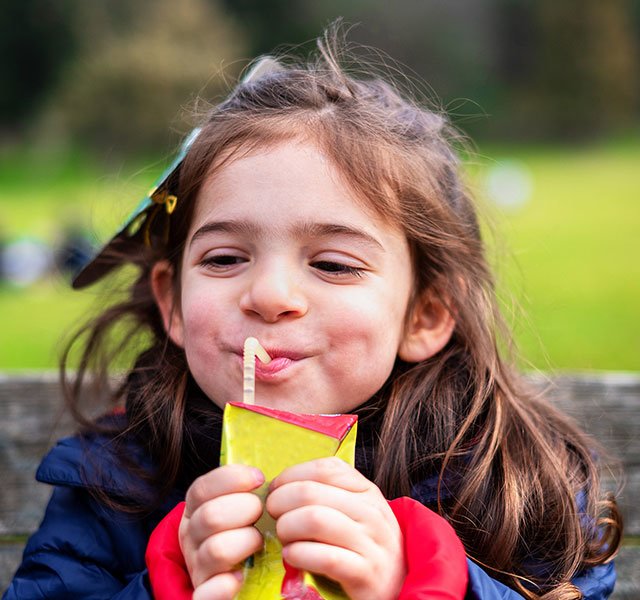A trip down the supermarket’s juice aisle can be surprisingly confusing. If you’re not careful what you grab, you may not be bringing home the healthiest juice for your kids. And those eye-catching labels and unclear claims on drink bottles are no accident.
“According to a study done by the World Health Organization, 50% to 90% of food marketing is focused on junk food, and a lot of that is geared toward kids,” says Alyssa Katz, R.D., a community dietitian with Henry Ford’s Generation with Promise team. “They purposely use fun colors, cartoon characters or celebrities to make the products more appealing.”
Decoding Confusing Claims
The front of the drink bottle — the part you see as you quickly scan the supermarket shelves — is carefully designed to lure you in. So it pays to be wary of the words you find on that front label. “It’s going to say things that make you want to pick it up off the shelf,” says Katz.
Some common (and often misleading) label claims include:
- All-natural ingredients
- Excellent source of vitamin C
- Made with real fruit juice
- Juice drink
- Fruit drink
The problem with the language you find on the front label is that it rarely tells the whole story. “Manufacturers deliberately choose wording that makes the product sound more nutritious,” says Katz. But the only phrase you really want to see on the front of your drink bottle is “100% juice.” That line is your guarantee that what you’re buying is, in fact, nothing but juice.
Read The Back Of The Bottle
No matter what the label on the front may claim, you can quickly get to the truth by simply turning the bottle around. “You need to read the ingredients and also check the nutrition facts panel,” says Katz.
The ingredients listing provides important insights that can help decode the front label language. For example, check to see if the ingredients list includes “ascorbic acid” (another name for vitamin C). If it does, you’ll know that the reason the drink is an “excellent source of vitamin C” is because they added it in — not because you’re getting it from real fruit.
One popular “juice drink” proudly proclaims on the front of its package that it contains all-natural ingredients. And while that may be true, few of those natural ingredients are juice. A check of the back label reveals that the first two ingredients in the drink are water and sugar.
The nutrition facts panel will tell you how much sugar is in the drink you’re buying. “Any fruit juice, including a drink that’s 100% juice, will have a high sugar content because fruit naturally contains sugar,” says Katz. “So it’s important to check if a juice beverage has any added sugar and also compare different types of juice to see which ones naturally contain more sugar."
Ideally, you want to choose a drink that has no added sugar. By definition, a product that is 100% juice will contain 0% added sugar.
Healthy Juice Guidelines For Kids
Even after you’ve found the healthiest juice (one that’s 100% juice and nothing else), it’s still wise to limit how much of it your kids guzzle down. Drinking too much fruit juice is linked to the development of cavities in young children. And it can also fill kids up so that they don’t eat enough healthy foods.
The current nutritional guidelines recommend:
- Children under 12 months should not drink any juice
- Children 1 to 3 years old shouldn’t have more than 4 ounces of juice per day
- Children 4 to 6 years old shouldn’t have more than 4 to 6 ounces per day
- Children 7 to 18 shouldn’t have more than 8 ounces per day
You can reduce the amount of juice your kids are drinking by diluting it. To give them the flavor without the extra sugar and calories, Katz suggests mixing juice 50/50 with water. “You can also add fresh fruit to water and let it infuse overnight or make juice ice cubes to put in your child’s water,” she says.
“A glass of juice is considered a serving of fruit, but it’s best to encourage kids to eat the whole food, not just the juice,” says Katz. Drinking juice means missing out on all of the fiber you find in whole fruits.
“Kids’ taste preferences are forming, so it’s important to help them develop a taste for fruit and other healthy whole foods,” says Katz.
To find a doctor or registered dietitian at Henry Ford, visit henryford.com or call 1-800-436-7936.
Alyssa Katz is a community dietitian with Henry Ford’s Generation with Promise team.



